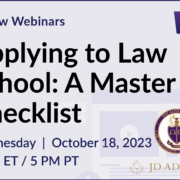LSAT-Flex: What You Need To Know
LSAT-Flex: What You Need To Know
In response to the COVID-19 pandemic, the Law School Admission’s Council (LSAC) recently introduced a new, online, remotely proctored version of the LSAT—the “LSAT Flex.” Thus far, the LSAT-Flex has only been made available as an option for those students who were registered for the now-canceled April 2020 LSAT. If you were registered for the April test as of April 7th and would like to try your hand at the LSAT-Flex, the sign-up process opened on Thursday, April 23. It will be administered on May 18th and 19th—LSAC has yet to announce time(s) for the test.
UPDATE: The June 2020 in-person LSAT has also been canceled and the LSAT-Flex will be remotely administered in its place on June 14 and June 15. For more information check out the LSAC website.
LSAT-Flex: What You Need To Know
Here’s a breakdown of what you need to know:
I’m Not Taking the LSAT Until June 2020: Will the LSAT-Flex Still be Around Then?
The LSAT-Flex will be offered in June as well since the in-person exam has been canceled. So, if you’ve already been proactive and re-registered for the LSAT in June or later, it’s important to learn all you can about it!
Is the LSAT-Flex Different from the Regular LSAT?
Yes, in several ways:
- The LSAT-Flex administered in May will only have three, 35-minute multiple-choice sections. Usually, the LSAT has 5 sections—4 scored and 1 unscored.
- The LSAT-Flex will contain one section of Logical Reasoning, one section of Analytical Reasoning (Logic Games), and one section of Reading Comprehension. So, while Logical Reasoning usually makes up 50% of your LSAT score, on the LSAT Flex Logical Reasoning is only 33% of your total score. On the other hand, Logic Games will be 33% of your score, too. Usually, it’s only 25%
This means that if you struggle with tackling LSAT Logical Reasoning Questions, you could perform better on the LSAT-Flex than you would on the “regular” LSAT.
However, if you struggle with Logic Games, then the LSAT-Flex might be a bit more difficult.
- Regular test-takers will be given approximately 2 hours to complete the exam. Generally, you are given about 3 hours and 30 minutes in total. If timing and endurance on the LSAT have been issues for you, the LSAT-Flex may be advantageous.
- No break. Though the LSAT-Flex is shorter, there is a tradeoff—students will have to take the entire exam in one block. That means a straight 2 hours (roughly) of testing!
- You can take the LSAT-Flex from anywhere. However, you must be able to use and access ProctorU, the online-proctoring tool for the LSAT-Flex. If you plan to take the LSAT-Flex, start thinking about a quiet, comfortable place where you can take it.
- You will be able to choose your testing time. You will be able to take the exam on either Monday, May 18th or Tuesday, May 19th. LSAC still needs to release specifics on this. However, it seems that there may be multiple slots—perhaps even times in the afternoon and evening!
If you’re signed up for the June exam, LSAC may well offer the same sort of flexible timing.
Wait…Does the LSAT-Flex Require that I Take the LSAT Writing Portion?
Yes. You will still need to take the Writing Portion of the exam. As with the regular LSAT, the Writing portion will be available in your LSAC account as soon as your administration date arrives.
When Will I Get My Score?
Currently, LSAC has a “target” score release date of June 5th, 2020 for the May test and June 30th for the June test.
Will My Dream Law School Accept My LSAT-Flex Score?
LSAC claims that it has received “overwhelming support” for the new format from its member law schools. However, LSAC also recommends that candidates talk with the schools to which they are applying to ensure the LSAT-Flex is accepted.
So, How do I Prepare for the LSAT-Flex?
You ought to prepare for this test in the same way that you prepare for the Regular LSAT. Make sure you obtain the right LSAT Prep Materials. Also, create and follow your LSAT Study Schedule. This should include time to both familiarize yourself with the LSAT and do plenty of practice questions and timed sections.
I Need Tutoring for the LSAT-Flex…Can J.D. Advising Help?
Yes! If you need additional tutoring or assistance, sign up for J.D. Advising’s LSAT-Flex tutoring programs today!
Looking For LSAT Help?
Looking for LSAT tutoring? We offer personalized, one-on-one tutoring from experts who scored in the 95% percentile and above on the LSAT. You can read about our LSAT tutoring and pre-law options here.








Leave a Reply
Want to join the discussion?Feel free to contribute!